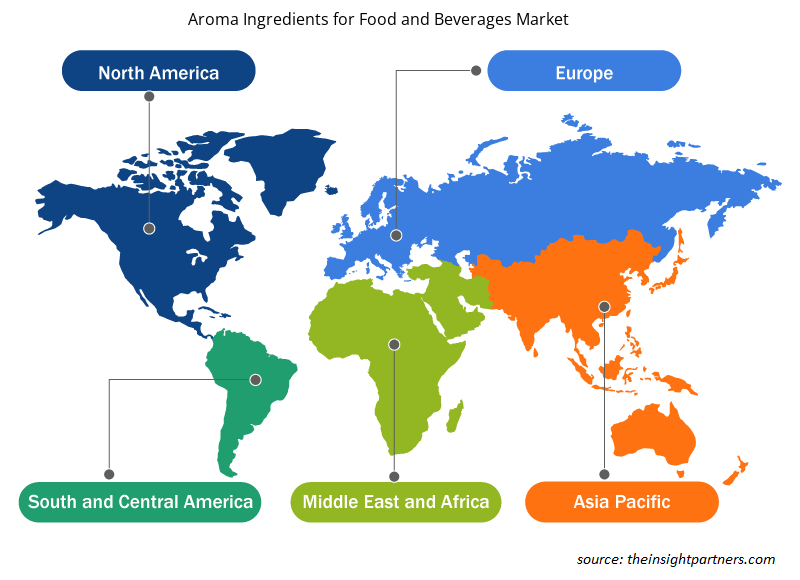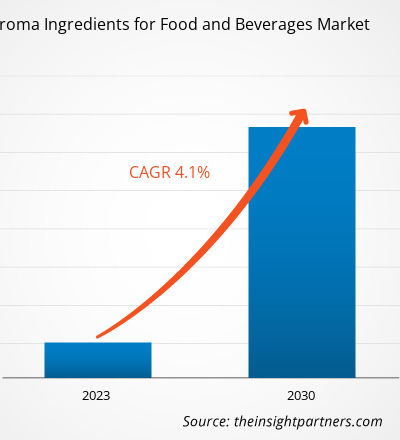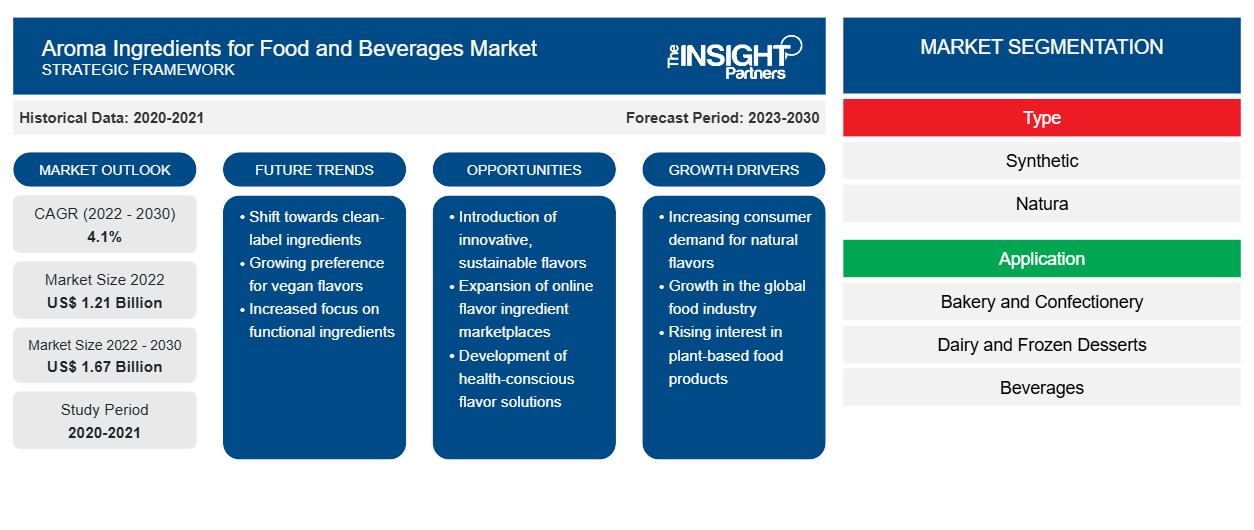[Rapport de recherche] La taille du marché des ingrédients aromatiques pour les aliments et les boissons devrait passer de 1,21 milliard de dollars américains en 2022 à 1,67 milliard de dollars américains d'ici 2030 ; le marché devrait enregistrer un TCAC de 4,1 % de 2022 à 2030.
Informations sur le marché et point de vue des analystes :
Les ingrédients aromatiques sont isolés à partir d'ingrédients d'origine naturelle ou extraits chimiquement du pétrole. Ces ingrédients jouent un rôle crucial dans la définition du profil de saveur et d'arôme de divers produits alimentaires et boissons, allant des confiseries et des snacks salés aux boissons alcoolisées et non alcoolisées. L'importance croissante des ingrédients aromatiques dans l'industrie alimentaire et des boissons et les initiatives stratégiques des principaux acteurs du marché sont des facteurs majeurs qui stimulent les ingrédients aromatiques pour le marché des aliments et des boissons. En outre, la demande croissante des consommateurs pour des expériences de saveur et d'arôme uniques et exotiques, ainsi que les progrès des techniques d'extraction et de synthèse, contribuent à façonner le paysage du marché. Cependant, les contraintes réglementaires associées à l'utilisation d'ingrédients aromatiques dans l'industrie alimentaire et des boissons entravent la croissance du marché des ingrédients aromatiques pour les aliments et les boissons .
Moteurs de croissance et défis :
Les fabricants d'ingrédients aromatiques du secteur des aliments et des boissons participent activement aux fusions et acquisitions, aux collaborations et à d'autres développements stratégiques pour attirer les consommateurs et renforcer leur position sur le marché. La demande croissante d'ingrédients aromatiques de la part de divers établissements du secteur de l'alimentation et des boissons qui produisent et vendent des produits de boulangerie et de confiserie, des produits laitiers, des desserts glacés et d'autres articles a conduit les principaux acteurs à adopter des initiatives stratégiques pour renforcer leur position sur le marché mondial. Par exemple, en novembre 2023, BASF SE a annoncé le lancement de deux nouveaux ingrédients aromatiques naturels : Isobionics Natural alpha-Bisabolene 98 et Isobionics Natural (-)-alpha-Bisabolol 99. Ces développements de produits stimulent les ingrédients aromatiques pour le marché des aliments et des boissons.
Les principaux acteurs du marché développent leurs installations de production et concluent des accords avec des distributeurs pour renforcer leur position sur le marché. Par exemple, en décembre 2021, Tilley Distribution, Inc. a annoncé la fusion avec Phoenix Aromas and Essential Oils. Cette fusion permettra de fournir des produits de haute qualité aux consommateurs nouveaux et existants avec des équipes expérimentées dans le soutien réglementaire et technique. De plus, en juillet 2021, Symrise AG a acquis Giraffe Foods Inc., un producteur canadien de sauces, trempettes, vinaigrettes, sirops et concentrés de boissons personnalisés pour les clients B2B. Cette acquisition permettra d'élargir le segment Arômes et nutrition de Symrise en Amérique du Nord, renforçant ainsi sa position sur le marché et sa clientèle. Ainsi, les initiatives stratégiques des principaux acteurs du marché alimentent la croissance du marché mondial des ingrédients aromatiques pour les aliments et les boissons.
La production et l’utilisation d’ingrédients aromatiques dans diverses applications alimentaires et de boissons sont réglementées par diverses agences gouvernementales. Les organismes de réglementation tels que la Food and Drug Administration (FDA) et l’Autorité européenne de sécurité des aliments ( EFSA ) imposent des directives et des normes strictes sur l’utilisation d’ingrédients aromatiques afin de garantir la sécurité des consommateurs et la qualité des produits. Par exemple, le Programme des Nations Unies pour l’environnement a réglementé l’utilisation d’arômes alimentaires. Cette réglementation prévoit toutes les conditions nécessaires à l’utilisation correcte, contrôlée et sûre des arômes et des ingrédients aromatiques ou des arômes dans les aliments. En outre, la Food and Drug Administration (FDA) a imposé une réglementation sur les arômes alimentaires qui peuvent être utilisés dans et sur les aliments. Le respect de ces exigences réglementaires s’accompagne de processus de test et de documentation approfondis, qui peuvent prendre du temps et coûter cher aux fabricants. Le processus d’approbation des ingrédients aromatiques peut être long et complexe, ce qui entrave encore davantage l’innovation et le développement de produits au sein de l’industrie.
Personnalisez ce rapport en fonction de vos besoins
Vous bénéficierez d'une personnalisation gratuite de n'importe quel rapport, y compris de certaines parties de ce rapport, d'une analyse au niveau des pays, d'un pack de données Excel, ainsi que de superbes offres et réductions pour les start-ups et les universités.
-
Obtenez les principales tendances clés du marché de ce rapport.Cet échantillon GRATUIT comprendra une analyse de données, allant des tendances du marché aux estimations et prévisions.
Segmentation et portée du rapport :
L'analyse du marché mondial des ingrédients aromatiques pour les aliments et les boissons jusqu'en 2030 est une étude spécialisée et approfondie axée principalement sur les tendances du marché et les opportunités de croissance. Le rapport vise à fournir un aperçu du marché avec une segmentation détaillée du marché par type et application. Le marché a connu une forte croissance ces derniers temps et devrait poursuivre cette tendance au cours de la période de prévision. Le rapport fournit des statistiques clés sur la consommation d'ingrédients aromatiques pour les aliments et les boissons à l'échelle mondiale. En outre, le rapport sur le marché mondial des ingrédients aromatiques pour les aliments et les boissons fournit une évaluation qualitative de divers facteurs affectant la performance du marché à l'échelle mondiale. Le rapport comprend également une analyse complète des principaux acteurs du marché et de leurs principaux développements stratégiques. Plusieurs analyses sur la dynamique du marché sont également incluses pour aider à identifier les principaux facteurs moteurs, les tendances du marché et les opportunités lucratives qui, à leur tour, aideraient à identifier les principales poches de revenus.
Les prévisions du marché des ingrédients aromatiques pour les aliments et les boissons sont estimées sur la base de diverses conclusions de recherche secondaires et primaires, telles que les publications clés des entreprises, les données des associations et les bases de données. En outre, l'analyse de l'écosystème et l'analyse des cinq forces de Porter fournissent une vue à 360 degrés du marché, ce qui permet de comprendre l'ensemble de la chaîne d'approvisionnement et les différents facteurs affectant les performances du marché.
Analyse segmentaire :
Les ingrédients aromatiques destinés au marché des aliments et des boissons sont segmentés en fonction du type et de l'application.Le marché est divisé en synthétique et naturel. Le segment synthétique est en outre segmenté en terpènes, aldéhydes, aliphatiques et autres. Le segment naturel est en outre divisé en huiles essentielles , extraits de plantes, oléorésines et autres. En 2022, le segment synthétique détenait la plus grande part de marché des ingrédients aromatiques pour les aliments et les boissons. Le segment naturel devrait enregistrer le TCAC le plus élevé de 2022 à 2030. Les ingrédients aromatiques synthétiques sont des composés chimiques qui imitent les arômes naturels présents dans les aliments et les boissons. La forte augmentation de la demande pour ces ingrédients dans l'industrie alimentaire et des boissons peut être attribuée à plusieurs facteurs. Premièrement, les ingrédients aromatiques synthétiques offrent une cohérence dans le profil de saveur, garantissant que les produits ont le même goût à chaque fois, quelles que soient les variations des ingrédients naturels. Cette cohérence est cruciale pour l'identité de la marque et la satisfaction du consommateur. Deuxièmement, ils offrent une rentabilité par rapport aux ingrédients aromatiques naturels, ce qui les rend plus accessibles aux fabricants, en particulier dans la production à grande échelle. De plus, les progrès de la science des arômes ont conduit au développement d’ingrédients synthétiques qui reproduisent fidèlement les arômes naturels, satisfaisant ainsi les préférences des consommateurs pour des goûts familiers tout en offrant des combinaisons de saveurs uniques. En conclusion, les préoccupations concernant la stabilité et la disponibilité des ingrédients naturels et les pressions réglementaires ont encore favorisé l’adoption d’ingrédients aromatiques synthétiques dans l’industrie alimentaire et des boissons.
Analyse régionale :
Le marché est concentré sur cinq régions clés : l'Amérique du Nord, l'Europe, l'Asie-Pacifique, le Moyen-Orient et l'Afrique, ainsi que l'Amérique du Sud et l'Amérique centrale. L'Asie-Pacifique représentait la plus grande part de marché des ingrédients aromatiques pour l'alimentation et les boissons en 2022, avec une valeur marchande d'environ 425 millions de dollars américains.L’Europe représente la deuxième part la plus importante, suivie de l’Amérique du Nord.
En Europe, la demande croissante d'ingrédients aromatiques peut être attribuée aux riches traditions culinaires de la région et à la préférence croissante pour les produits haut de gamme et artisanaux. Il existe une forte appréciation culturelle des traditions culinaires et de la cuisine dans toute l'Europe. Les consommateurs européens apprécient les ingrédients de haute qualité et les saveurs authentiques, ce qui stimule la demande d'ingrédients aromatiques qui améliorent l'expérience sensorielle. Cet accent mis sur l'excellence gastronomique a conduit à un marché croissant d'ingrédients aromatiques haut de gamme provenant de sources naturelles et durables, répondant aux goûts exigeants des consommateurs européens. En outre, l'intérêt croissant pour des options alimentaires plus saines et plus naturelles en Europe contribue à la croissance du marché. Les consommateurs européens ont adopté des régimes alimentaires biologiques et à base de plantes, incorporant souvent des ingrédients aux goûts et parfums forts ou inconnus, tels que certains légumes, céréales et légumineuses. Pour rendre ces choix soucieux de la santé plus attrayants, les fabricants de produits alimentaires utilisent des ingrédients aromatiques pour atténuer les saveurs et parfums trop forts ou désagréables, garantissant ainsi que les produits conservent une large acceptation des consommateurs tout en adhérant aux tendances naturelles et clean-label. Cette demande s’aligne sur la qualité alimentaire européenne plus large, sur le goût et sur la prise en compte de l’expérience sensorielle, contribuant ainsi à l’adoption d’ingrédients aromatiques pour les aliments et les boissons dans la région.
En Amérique du Nord, les ingrédients aromatiques destinés au marché des aliments et des boissons sont attribués à la hausse des ventes de produits alimentaires prêts à l'emploi et emballés, à l'industrie alimentaire bien établie et à la préférence croissante des consommateurs pour les boissons fonctionnelles. Les ingrédients aromatiques jouent un rôle essentiel dans ces produits pour améliorer l'arôme global des produits, les rendant plus attrayants pour les consommateurs. La préférence croissante des consommateurs pour les produits naturels et clean label a également contribué à la croissance du marché. Alors que la sensibilisation à la santé et au bien-être continue de croître, les consommateurs recherchent de plus en plus des produits contenant des ingrédients aromatiques naturels. Cela a conduit les fabricants d'aliments et de boissons à incorporer des ingrédients aromatiques dérivés de sources naturelles telles que les fruits, les herbes et les épices pour répondre à la demande des consommateurs. En outre, les tendances du marché des ingrédients aromatiques pour les aliments et les boissons vers la premiumisation dans le secteur des aliments et des boissons ont contribué à l'augmentation de la demande.
Aperçu régional du marché des ingrédients aromatiques pour les aliments et les boissons
Les tendances et facteurs régionaux influençant le marché des ingrédients aromatiques pour aliments et boissons tout au long de la période de prévision ont été expliqués en détail par les analystes d’Insight Partners. Cette section traite également des segments et de la géographie du marché des ingrédients aromatiques pour aliments et boissons en Amérique du Nord, en Europe, en Asie-Pacifique, au Moyen-Orient et en Afrique, ainsi qu’en Amérique du Sud et en Amérique centrale.

- Obtenez les données régionales spécifiques pour le marché des ingrédients aromatiques pour les aliments et les boissons
Portée du rapport sur le marché des ingrédients aromatiques pour les aliments et les boissons
| Attribut de rapport | Détails |
|---|---|
| Taille du marché en 2022 | 1,21 milliard de dollars américains |
| Taille du marché d'ici 2030 | 1,67 milliard de dollars américains |
| Taux de croissance annuel moyen mondial (2022-2030) | 4,1% |
| Données historiques | 2020-2021 |
| Période de prévision | 2023-2030 |
| Segments couverts |
Par type
|
| Régions et pays couverts |
Amérique du Nord
|
| Leaders du marché et profils d'entreprises clés |
|
Densité des acteurs du marché des ingrédients aromatiques pour les aliments et les boissons : comprendre son impact sur la dynamique commerciale
Le marché des ingrédients aromatiques pour aliments et boissons connaît une croissance rapide, tirée par la demande croissante des utilisateurs finaux en raison de facteurs tels que l'évolution des préférences des consommateurs, les avancées technologiques et une plus grande sensibilisation aux avantages du produit. À mesure que la demande augmente, les entreprises élargissent leurs offres, innovent pour répondre aux besoins des consommateurs et capitalisent sur les tendances émergentes, ce qui alimente davantage la croissance du marché.
La densité des acteurs du marché fait référence à la répartition des entreprises ou des sociétés opérant sur un marché ou un secteur particulier. Elle indique le nombre de concurrents (acteurs du marché) présents sur un marché donné par rapport à sa taille ou à sa valeur marchande totale.
Les principales entreprises opérant sur le marché des ingrédients aromatiques pour les aliments et les boissons sont :
- Saveurs et parfums internationaux Inc.
- Sensient Technologies Corp
- T Hasegawa Co Ltd
- BASF SE
- V Mane Fils Sas
Avis de non-responsabilité : les sociétés répertoriées ci-dessus ne sont pas classées dans un ordre particulier.

- Obtenez un aperçu des principaux acteurs du marché des ingrédients aromatiques pour les aliments et les boissons
Développements de l'industrie et opportunités futures :
Selon les communiqués de presse, quelques-unes des initiatives prises par les principaux acteurs opérant sur le marché des ingrédients aromatiques pour les aliments et les boissons sont énumérées ci-dessous :
- En mars 2023, BASF SE a annoncé son investissement dans une nouvelle usine à Zhanjiang, en Chine, et dans des usines de production de menthol et de linalol en aval à Ludwigshafen, en Allemagne. Cet investissement permettra d'étendre et de diversifier la chaîne de valeur des ingrédients aromatiques de BASF en Allemagne et en Malaisie et de soutenir les opportunités de croissance des clients.
Paysage concurrentiel et entreprises clés :
International Flavors & Fragrances Inc, Sensient Technologies Corp, T Hasegawa Co Ltd, BASF SE, V Mane Fils Sas, Symrise AG, Firmenich International SA, Archer-Daniels-Midland Co, Kerry Group Plc et Berje Inc figurent parmi les principaux acteurs présentés dans le rapport sur le marché des ingrédients aromatiques pour les aliments et les boissons. Les acteurs du marché mondial se concentrent sur la fourniture de produits de haute qualité pour répondre à la demande des clients.
- Analyse historique (2 ans), année de base, prévision (7 ans) avec TCAC
- Analyse PEST et SWOT
- Taille du marché Valeur / Volume - Mondial, Régional, Pays
- Industrie et paysage concurrentiel
- Ensemble de données Excel
Rapports récents
Rapports connexes
Témoignages
Raison d'acheter
- Prise de décision éclairée
- Compréhension de la dynamique du marché
- Analyse concurrentielle
- Connaissances clients
- Prévisions de marché
- Atténuation des risques
- Planification stratégique
- Justification des investissements
- Identification des marchés émergents
- Amélioration des stratégies marketing
- Amélioration de l'efficacité opérationnelle
- Alignement sur les tendances réglementaires























 Obtenez un échantillon gratuit pour - Ingrédients aromatiques pour le marché des aliments et des boissons
Obtenez un échantillon gratuit pour - Ingrédients aromatiques pour le marché des aliments et des boissons